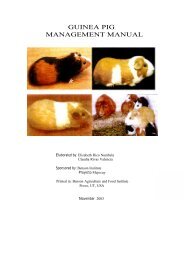Walipini Construction (The Underground Greenhouse) - Ezra Taft ...
Walipini Construction (The Underground Greenhouse) - Ezra Taft ...
Walipini Construction (The Underground Greenhouse) - Ezra Taft ...
Create successful ePaper yourself
Turn your PDF publications into a flip-book with our unique Google optimized e-Paper software.
assisting plant growth.<br />
Cutting Down Heat Loss -- Insulation<br />
A double layer of plastic sheeting (glazing) should be used on the roof. This provides a form of<br />
insulation and slows down the escaping of heat during the nighttime. This sealed dead-air space<br />
between the plastic sheeting should be between 3/4” to 4” thick. Poles used to span the roof that<br />
are 3.5” to 4” in diameter provide the indicated thickness of dead air space when plastic sheeting<br />
is affixed to the outside and the inside of the roof’s structure. <strong>The</strong> inside sheeting also keeps the<br />
inside humidity from penetrating and rotting the wooden poles spanning the roof.<br />
All above-ground walls should be bermed with as much soil as possible. This provides some<br />
extra mass, but provides much more insulation against above-ground cold temperature, winds<br />
and moisture penetration.<br />
When nighttime temperatures are continuously well below freezing, insulated shutters made<br />
from foam insulation board or canvas sheets filled with straw or grass can be placed over the<br />
glazing. This requires more work and storage, and in many environments is unnecessary, such<br />
as is the case in the area of La Paz, Bolivia.<br />
II. Location of the <strong>Walipini</strong>:<br />
<strong>The</strong> Danger of Water Penetration<br />
Water penetration of the walls and/or floor of the <strong>Walipini</strong> is destructive. If water seeps through<br />
the walls, they will collapse. If water comes up through the floor, it will adversely affect plant<br />
growth and promote plant disease. Dig the <strong>Walipini</strong> in an area where its bottom is at least 5’<br />
above the water table. When all of the above ground walls are bermed, a layer of water-proof<br />
clay, such as bentonite, or plastic sheeting, should be buried approximately 6” to 1’ under the<br />
berm surface. It should be slanted so that the water drains away from the <strong>Walipini</strong> to the<br />
drainage ditches. In some cases where the soil has a low permeability rate, the clay or plastic<br />
may not be necessary. Be sure to dig a shallow drainage ditch around the perimeter of the<br />
<strong>Walipini</strong> which leads run off water well away from the structure.<br />
-4



